Sony SNC-CS20, SNC-CM120, SNC-DM110, SNC-DM160, SNC-DS10 User Manual
...
3-873-172-11 (1)
Network Camera
User’s Guide
Software Version 1.0
SNC-DM110/SNC-DS10
SNC-DM160/SNC-DS60
SNC-CM120/SNC-CS20
© 2008 Sony Corporation

Table of Contents |
|
Overview |
|
Features .................................................................. |
4 |
How to Use This User’s Guide .............................. |
5 |
System Requirements ............................................ |
5 |
Preparation |
|
Assigning the IP Address to the Camera ............ |
6 |
Assigning an IP address using the IP Setup |
|
Program ............................................................ |
6 |
When using Windows XP Service Pack 2 .......... |
8 |
When using Windows Vista ............................. |
10 |
Accessing the Camera Using the Web Browser 13 |
|
Basic Configuration by the Administrator ....... |
15 |
Operating the Camera |
|
Administrator and User ...................................... |
16 |
Logging in to Homepage — Welcome Page ...... |
17 |
Logging in as a user ......................................... |
17 |
Displaying the Administrator menu directly .... |
18 |
About viewers .................................................. |
18 |
Configuration of Main Viewer ........................... |
19 |
Main menu ....................................................... |
19 |
Camera control section ..................................... |
19 |
Monitor image section ..................................... |
20 |
Controlling the Monitor Image .......................... |
21 |
Monitoring the camera image .......................... |
21 |
Zooming in the monitor image ......................... |
22 |
Capturing a Monitor Image ............................... |
22 |
Capturing a monitor image .............................. |
22 |
Saving the captured image ............................... |
23 |
Operating the Camera Using SolidPTZ (SNC- |
|
DM110 / DM160 / CM120 only) ......................... |
23 |
Controlling via the control panel ..................... |
23 |
Panning and tilting by clicking the monitor |
|
image .............................................................. |
24 |
Panning, tilting and zooming by specifying the |
|
area ................................................................. |
24 |
Zooming an image by the camera zoom bar .... |
24 |
Displaying the preset area of the image ........... |
24 |
Controlling the Camera on a Full Image (SNC- |
|
DM110 / DM160 / CM120 only) ......................... |
25 |
Displaying a specified point in the monitor |
|
window ........................................................... |
25 |
Using the Trigger Button ................................... |
26 |
Sending a monitor image via e-mail ................ |
26 |
Sending a monitor image to an FTP server ...... |
26 |
Recording a camera image as a still image ....... |
26 |
Controlling alarm output 1, 2 ........................... |
26 |
Controlling Day/Night function (SNC-DM160 / |
|
DS60 / CM120 / CS20 only) .......................... |
26 |
Playing the audio file stored in the camera ....... |
27 |
Administrating the Camera |
|
Basic Operations of Administrator Menu ......... |
28 |
How to setup the Administrator menu .............. |
28 |
Configuration of Administrator menu .............. |
29 |
Configuring the System — System Menu .......... |
30 |
System Tab ........................................................ |
30 |
Date & time Tab ................................................ |
32 |
Installation Tab ................................................. |
33 |
Initialize Tab ..................................................... |
34 |
System log Tab ................................................. |
35 |
Access log Tab .................................................. |
35 |
Setting the Camera Image and Audio — Camera |
|
Menu ..................................................................... |
35 |
Common Tab .................................................... |
35 |
Picture Tab ........................................................ |
36 |
Sense up Tab (SNC-DM110 / DM160 / DS60 / |
|
CM120 / CS20 only) ...................................... |
38 |
Video codec Tab ............................................... |
40 |
Streaming Tab ................................................... |
44 |
Configuring the Network — Network Menu ..... |
46 |
Network Tab ..................................................... |
46 |
Dynamic IP address notification Tab — Notifying |
|
the IP Address ................................................. |
47 |
Using the 802.1X Authentication Function — |
|
802.1X Menu ......................................................... |
49 |
System configuration of 802.1X network ........ |
49 |
Common Tab – Basic setting of 802.1X |
|
authentication function ................................... |
49 |
Client certificate Tab ......................................... |
50 |
CA certificate Tab ............................................. |
51 |
Setting the 802.1X authentication function – |
|
Example of Windows Server 2003 ................. |
51 |
Setting the User — User Menu ........................... |
54 |
Setting the Security — Security Menu ............... |
55 |
Saving the SolidPTZ Display Area and Action |
|
— Preset position Menu (SNC-DM110 / DM160 / |
|
CM120 only) ......................................................... |
56 |
Position Tab — Saving pan/tilt/zoom position .56 |
|
Tour Tab — Setting a tour ................................ |
57 |
Sending an Image via E-mail — e-Mail (SMTP) |
|
Menu ..................................................................... |
59 |
Common Tab — Setting the e-Mail (SMTP) |
|
Function .......................................................... |
59 |
Alarm sending Tab — Setting the e-mail sending |
|
mode when detecting the alarm ...................... |
60 |
2 Table of Contents

Periodical sending Tab — Setting the periodical e- |
|
mail sending mode ......................................... |
61 |
Sending Images to FTP Server — FTP client |
|
Menu ..................................................................... |
62 |
Common Tab — Setting the FTP client |
|
function .......................................................... |
62 |
Alarm sending Tab — Setting the FTP client |
|
action when detecting the alarm ..................... |
63 |
Periodical sending Tab — Setting the periodical |
|
FTP client activity .......................................... |
64 |
Recording Images in Memory — Image memory |
|
Menu ..................................................................... |
65 |
Common Tab — Setting the image memory |
|
function .......................................................... |
65 |
Alarm recording Tab — Setting the Image |
|
memory function when detecting the alarm ... |
66 |
Periodical recording Tab — Setting the periodical |
|
recording mode ............................................... |
67 |
Folder structure of image memory ................... |
67 |
Downloading Images from the Camera — FTP |
|
server Menu ......................................................... |
68 |
Setting the Alarm Output— Alarm output |
|
Menu ..................................................................... |
69 |
Alarm out 1, 2 Tab ............................................ |
69 |
Outputting Audio Linked to Alarm Detection |
|
— Voice alert Menu ............................................. |
70 |
Voice alert 1, 2, 3 Tab ....................................... |
70 |
Setting the Operations from the Viewer — Trigger |
|
Menu ..................................................................... |
71 |
Setting the Schedule — Schedule Menu ............ |
73 |
Setting the Alarm Buffer — Alarm buffer |
|
Menu ..................................................................... |
74 |
Setting the Motion Detection Function — Motion |
|
detection Menu .................................................... |
75 |
Setting Tab ........................................................ |
75 |
Others |
|
Using the Supplied IP Setup Program ............... |
78 |
Starting the IP Setup Program .......................... |
78 |
Bandwidth control Tab ..................................... |
78 |
Date time Tab ................................................... |
79 |
Rebooting the Camera ...................................... |
79 |
Using the SNC audio upload tool — Transmitting |
|
Audio to Camera .................................................. |
80 |
Installing the SNC audio upload tool ............... |
80 |
Connecting the Camera to the Computer ......... |
80 |
Using the SNC audio upload tool ..................... |
80 |
Using the SNC video player — Playing Video/ |
|
Audio File Recorded with Camera ..................... |
85 |
Installing the SNC video player ....................... |
85 |
Using the SNC video player ............................. |
86 |
Using the SNC privacy masking tool — |
|
Masking a Camera Image ................................... |
87 |
Installing the SNC privacy masking tool .......... |
87 |
Using the SNC privacy masking tool ................ |
87 |
Setting a privacy mask ...................................... |
88 |
Using the Custom Homepage Installer .............. |
89 |
Uploading the homepage to the camera using the |
|
Custom Homepage Installer ........................... |
89 |
Assigning the IP Address to the Camera Using |
|
ARP Commands ................................................... |
91 |
Using the SNMP ................................................... |
92 |
1. Inquiry Commands ...................................... |
92 |
2. Setting Commands ....................................... |
92 |
Specifications ........................................................ |
93 |
Glossary ................................................................ |
94 |
Index ...................................................................... |
97 |
Table of Contents |
3 |
|
|

Overview
Overview
Features
–High-resolution, high-sensitivity image thanks to ExwavePRO technology complementary filter progressive scan CCD
–Easy focus adjustment with iris open button and focus assist functions
–Improved alarm accuracy by using the intelligent motion detection function that ignores environmental noise
–Delivers JPEG 30 fps and MPEG4 30 fps images simultaneously on VGA size by using a high-quality encoder
–Sets the correct exposure in harsh lighting conditions by setting the variable gamma
–Crops the image from the Quad-VGA 1280 × 960 view image by using the SolidPTZ function as if it were PTZ control. (SNC-DM110 / DM160 / CM120 only)
–Improved sensitivity at night by using the Light funnel function. (SNC-DM110 / DM160 / CM120 only)
NOTICE TO USERS
© 2008 Sony Corporation. All rights reserved. This manual or the software described herein, in whole or in part, may not be reproduced, translated or reduced to any machine readable form without prior written approval from Sony Corporation.
SONY CORPORATION PROVIDES NO WARRANTY WITH REGARD TO THIS MANUAL, THE SOFTWARE OR OTHER INFORMATION CONTAINED HEREIN AND HEREBY EXPRESSLY DISCLAIMS ANY IMPLIED WARRANTIES OF MERCHANTABILITY OR FITNESS FOR ANY PARTICULAR PURPOSE WITH REGARD TO THIS MANUAL, THE SOFTWARE OR SUCH OTHER INFORMATION. IN NO EVENT SHALL SONY CORPORATION BE LIABLE FOR ANY INCIDENTAL, CONSEQUENTIAL OR SPECIAL DAMAGES, WHETHER BASED ON TORT, CONTRACT, OR OTHERWISE, ARISING OUT OF OR IN CONNECTION WITH THIS MANUAL, THE SOFTWARE OR OTHER INFORMATION CONTAINED HEREIN OR THE USE THEREOF.
Sony Corporation reserves the right to make any modification to this manual or the information contained herein at any time without notice.
The software described herein may also be governed by the terms of a separate user license agreement.
•“IPELA” and  are trademarks of Sony Corporation.
are trademarks of Sony Corporation.
•“ExwavePRO” and  are trademarks of Sony Corporation.
are trademarks of Sony Corporation.
•Microsoft, Windows, Internet Explorer and MS-DOS are registered trademarks of Microsoft Corporation in the United States and/or other countries.
•Java is a trademark of Sun Microsystems, Inc. in the United States and other countries.
•Intel, Core and Pentium are registered trademarks of Intel Corporation or its subsidiaries in the United States and other countries.
•Adobe, Acrobat and Adobe Reader are trademarks of Adobe Systems Incorporated in the United States and/ or other countries.
All other company and product names are trademarks or registered trademarks of the respective companies or their respective makers.
4 Features

How to Use This User’s Guide
This User’s Guide explains how to operate the Network Camera from a computer.
The User’s Guide is written to be read on the computer display.
As this section gives tips on using the User’s Guide, read it before you operate the camera.
Jumping to the related page
When you read the User’s Guide on the computer display, click on the sentence to jump to the related page.
Software display examples
Note that the displays shown in the User’s Guide are explanatory examples. Some displays may be different from the ones which appear as you operate the application software.
The illustrations of the camera and menu display in the User’s Guide mainly show the SNC-DM160 as an example.
Printing the User’s Guide
Depending on your system, certain displays or illustrations in the User’s Guide, when printed out, may differ from those as portrayed on your screen.
Installation Manual (printed matter)
The supplied Installation Manual describes the names and functions of parts and controls of the Network Camera, connecting examples and how to set up the camera. Be sure to read the Installation Manual before operating.
System Requirements
|
SNC-DM110 |
SNC-DS10 |
|
|
|
|
|
||
|
|
|||
CPU |
SNC-DM160 |
SNC-DS60 |
|
Overview |
Intel Pentium 4 |
Intel Pentium 4 |
|
||
|
SNC-CM120 |
SNC-CS20 |
|
|
|
3 GHz or higher |
2.4 GHz or higher |
|
|
|
Intel Core 2 Duo |
Intel Core 2 Duo |
|
|
|
2 GHz or higher |
1.8 GHz or higher |
|
|
|
|
|
|
|
Memory |
1 GB or more |
|
|
|
|
|
|
|
|
OS |
Microsoft Windows XP, Windows Vista |
|
|
|
|
|
|
|
|
Web |
Microsoft Internet Explorer Ver. 6.0, 7.0 |
|
|
|
browser |
|
|
|
|
|
|
|
|
|
Display |
1600 × 1200 pixels |
1280 × 1024 pixels |
|
|
resolution |
or more |
or more |
|
|
(recommen |
|
|
|
|
ded) |
|
|
|
|
|
|
|
|
|
How to Use This User’s Guide / System Requirements |
5 |
|
|

Preparation
Preparation
The Preparation section explains what the administrator has to prepare for monitoring images after installation and connection of the camera.
Assigning the IP Address to the Camera
To connect the camera to a network, you need to assign a new IP address to the camera when you install it for the first time.
You can assign an IP address in two ways:
•Using the IP Setup Program stored in the supplied CDROM (see this page)
•Using the ARP (Address Resolution Protocol) commands (see page 91)
This section explains how to assign an IP address to the camera using the supplied setup program and how to configure the network.
Before starting, connect the camera, referring to “Connecting the Camera to a Local Network” in the supplied Installation Manual.
Consult the administrator of the network about the assigned IP address.
Notes
•The IP Setup Program may not operate correctly if you use a personal firewall or antivirus software in your computer. In that case, disable the software or assign an IP address to the camera using another method. For example, see “Assigning the IP Address to the Camera Using ARP Commands” on page 91.
•If you are using Windows XP Service Pack 2 or Windows Vista, disable the Windows Firewall function. Otherwise the IP Setup Program will not operate correctly. For the setting, see “Configuring Windows Firewall” in “When using Windows XP Service Pack 2” on page 9 or “Configuring Windows Firewall” in “When using Windows Vista” on
page 11.
Assigning an IP address using the IP Setup Program
1 Insert the CD-ROM in your CD-ROM drive.
A cover page appears automatically in your Web browser.
If it does not appear automatically in the Web browser, double-click on the index.htm file on the CD-ROM.
When you are using Windows Vista, pop-up “AutoPlay” may appear. For details, “Installing software” in “When using Windows Vista” on page 10.
2 Click the Setup icon of IP Setup Program. The “File Download” dialog opens.
When you are using Windows XP Service Pack 2 or Windows Vista, a message regarding the active contents may appear. For details, see “Installing software” in “When using Windows XP Service Pack 2” on page 8 or “Installing software” in “When using Windows Vista” on page 10.
3 Click Open.
Note
If you click “Save this program to disk” on the “File Download” dialog, you will not be able to perform set up correctly. Delete the downloaded file, and click the Setup icon again.
4 Install the IP Setup Program on your computer using the wizard.
If the Software License Agreement is displayed, read it carefully and click Accept to continue with the installation.
5 Start the IP Setup Program.
When you are using Windows Vista, message “User Account Control – An unidentified program wants access to your computer” may appear. In this case, click Allow.
The program detects the network cameras connected to the local network and lists them on the Network tab window.
6 Assigning the IP Address to the Camera
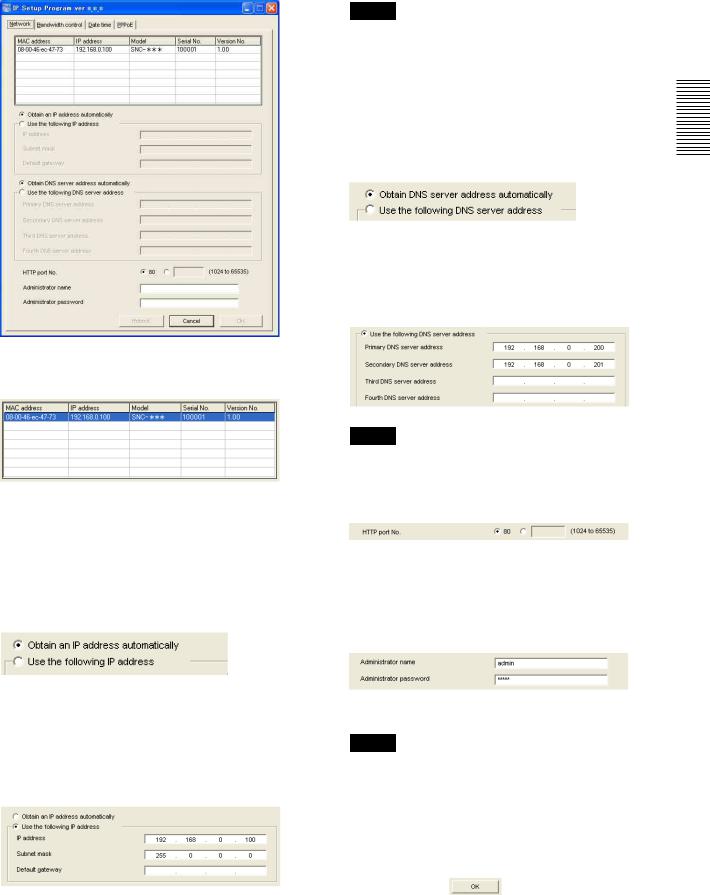
6 Click on the camera in the list to which you want to assign a new IP address.
The network settings for the selected camera are displayed.
7 Set the IP address.
To obtain the IP address automatically from a DHCP server:
Select Obtain an IP address automatically.
The IP address, Subnet mask and Default gateway are assigned automatically.
To specify the IP address manually:
Select Use the following IP address, and type the IP address, Subnet mask and Default gateway in the relevant boxes.
Note
When you select Obtain an IP address automatically, make sure that the DHCP server is operating on the network.
8 Set the DNS server address.
To obtain the DNS server addresses automatically:
Select Obtain DNS server address automatically.
Preparation
To specify the DNS server addresses manually: Select Use the following DNS server address, and type the Primary DNS server address and Secondary DNS server address in the relevant boxes.
Note
The Third DNS server address and Fourth DNS server address are invalid for this camera.
9 Set the HTTP port No.
Normally, select 80 for the HTTP port No. To use another port number, type the port number between 1024 and 65535 in the text box.
10 Type the Administrator name and Administrator password.
The factory settings of both items are “admin.”
Note
You cannot change the Administrator name and Administrator password in this step. To change these items, see “Setting the User — User Menu” on page 54.
11 Confirm that all items are correctly set, then click
OK.
Assigning the IP Address to the Camera |
7 |
|
|
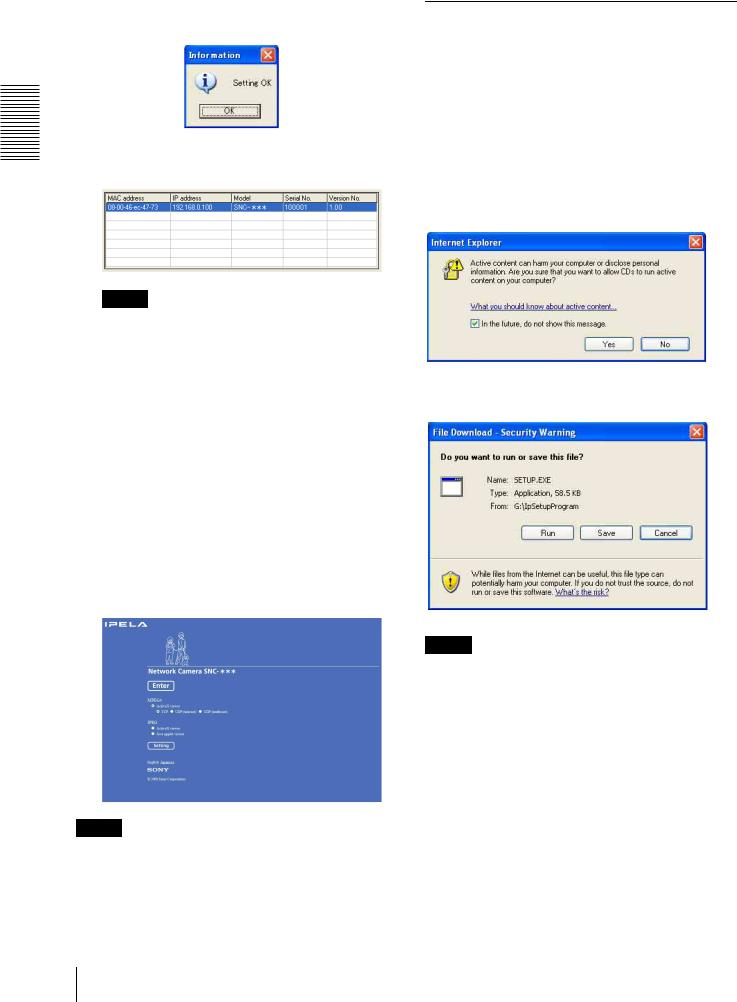
If “Setting OK” is displayed, the IP address is correctly assigned.
12 To access the camera directly, double-click the
Preparation |
camera name in the list. |
|
Tips
•The factory setting of the camera network is as follows.
IP address: 192.168.0.100 Subnet mask: 255.0.0.0
•When you select the camera in the network tab
and right-click Copy, and the camera’s MAC address, DHCP/FIXED*, IP address, Port number, Model name, Serial number and
Version number can be copied in the clipboard. When you hold down Ctrl and press a, you can select all cameras in the network tab.
*DHCP stands for a DHCP setting. FIXED stands for a fixed IP address.
The welcome page of the network camera is displayed on the Web browser.
Display sample: SNC-DM160
Note
If the IP address is not set correctly, the welcome page does not appear after step 12. In that case, try to set the IP address again.
When using Windows XP Service Pack 2
Installing software
A warning message regarding the active contents may appear when you install software such as IP Setup Program from CD-ROM. In this case, operate as follows:
Example: In case of IP Setup Program
If message “Internet Explorer” appears, click Yes.
If message “File Download – Security Warning” appears, click Run.
Note
If you select Save in the “File Download – Security Warning” dialog, you will not be able to perform installation correctly. Delete the downloaded file, and click the Setup icon again.
8 Assigning the IP Address to the Camera
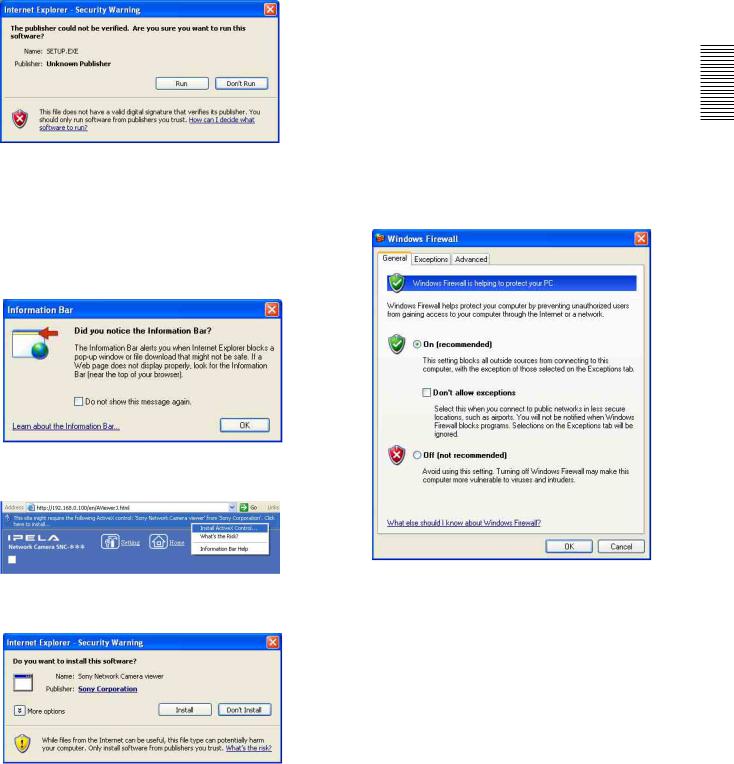
If message “Internet Explorer – Security Warning” appears, click Run.
The software installation starts.
Installing ActiveX Control
During installation of ActiveX Control, the information bar or “Security Warning” may appear. In this case, operate as follows:
If message “Information Bar” appears, click OK.
If the information bar appears, click on the bar and select
Install ActiveX Control….
If “ Internet Explorer – Security Warning” appears, click
Install.
The installation of ActiveX Control starts. When installation is completed, the main viewer or the Motion detection menu appears.
Configuring Windows Firewall
The IP Setup Program or SNC audio upload tool may not operate correctly depending on the configuration of Windows Firewall. (No cameras are shown in the list even if they are detected.) In this case, confirm the Windows Firewall configuration as follows:
Example: In case of IP Setup Program
1 Select Control Panel from the Start menu of Windows.
2 Select Security Center of the working field.
3 Select Windows Firewall and select Off in the Windows Firewall dialog.
The cameras will be displayed in the list.
If you want to keep Windows Firewall On, continue with the following steps.
4 Select the “Exceptions” tab.
Preparation
Assigning the IP Address to the Camera |
9 |
|
|
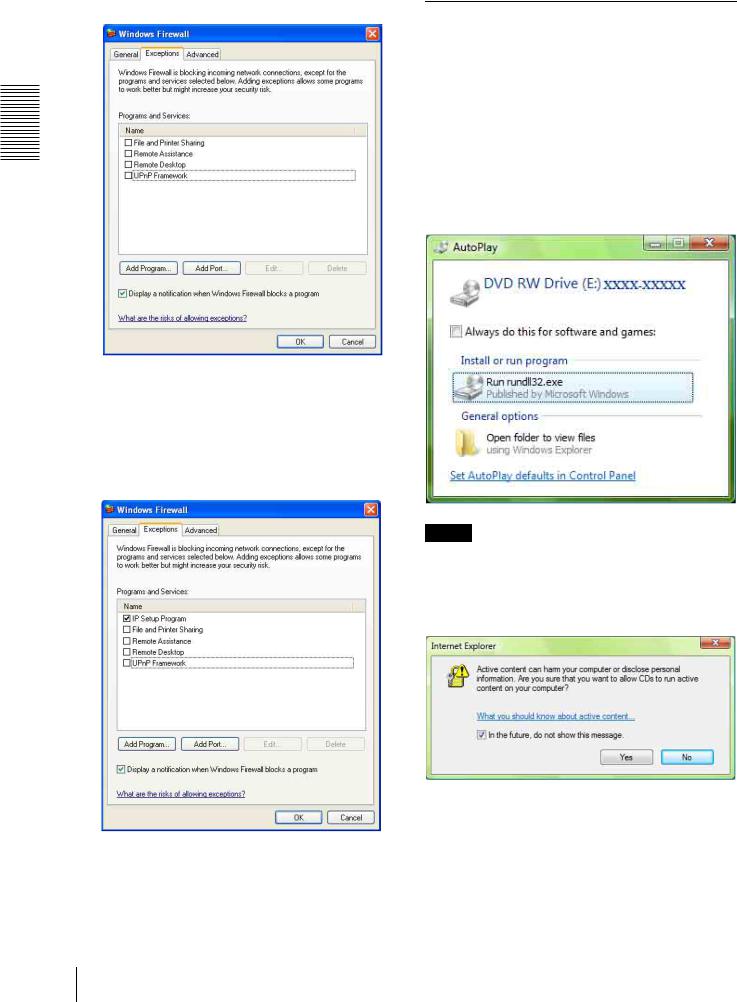
5 Select Add Program….
Preparation
6 In the Add Program dialog, select IP Setup Program and click OK.
Then the IP Setup Program is added to the
Programs and Services list.
7 Click OK.
When the above procedure is completed, the cameras connected in the local network are displayed in the IP Setup Program.
When using Windows Vista
Installing software
A warning message regarding the active contents may appear when you install software such as IP Setup Program from CD-ROM. In this case, operate as follows:
Example: In case of IP Setup Program
If pop-up “AutoPlay” appears when a CD-ROM is inserted into the CD-ROM drive, click Install or run program.
Note
If you click Open folder to view files, Web browser will not open automatically. In this case, double-click the “index.htm” file in the CD-ROM.
If message “Internet Explorer” appears, click Yes.
10 Assigning the IP Address to the Camera
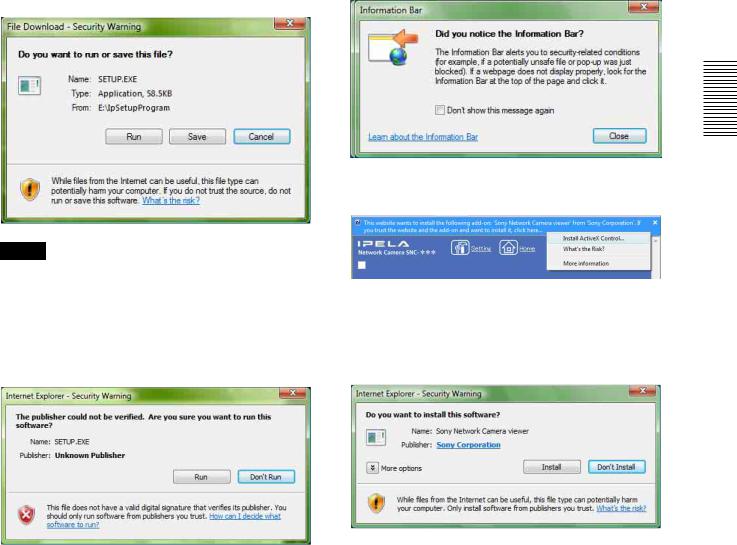
If message “File Download – Security Warning” appears, click Run.
Note
If you select Save in the “File Download – Security Warning” dialog, you will not be able to perform installation correctly. Delete the downloaded file, and click the Setup icon again.
If message “Internet Explorer – Security Warning” appears, click Run.
If message “User Account Control – An unidentified program wants access to your computer” appear, click
Allow.
The software installation starts.
Starting the software
When you start software such as IP Setup Program, message “User Account Control – An unidentified program wants access to your computer” may appear. In this case, click Allow.
Installing ActiveX Control
During installation of ActiveX Control, the information bar or “Security Warning” may appear. In this case, operate as follows:
If message “Information Bar” appears, click OK.
If the information bar appears, click on the bar and select
Install ActiveX Control….
If message “User Account Control – Windows needs your permission to continue” appear, click Continue.
If “Internet Explorer – Security Warning” appears, click
Install.
The installation of ActiveX Control starts. When installation is completed, the main viewer or the Motion detection menu appears.
Configuring Windows Firewall
The IP Setup Program or SNC audio upload tool may not operate correctly depending on the configuration of Windows Firewall. (No cameras are shown in the list even if they are detected.) In this case, confirm the Windows Firewall configuration as follows:
Example: In case of IP Setup Program
1 Select Control Panel from the Start menu of Windows.
2 Click Windows Firewall.
3 Select Turn Windows Firewall on or off. “User Account Control – Windows needs your permission to continue” may appear. In this case, click Continue.
Preparation
Assigning the IP Address to the Camera |
11 |
|
|
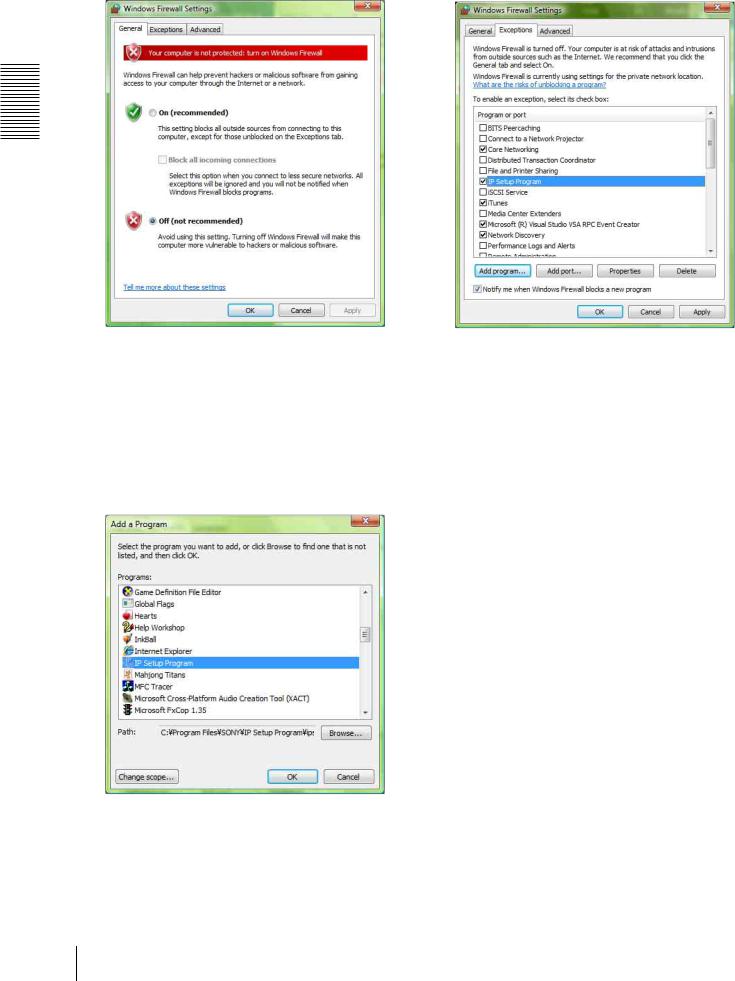
4 Select Off in the “General” tab. |
8 Click OK. |
Preparation
5
6
7
The cameras will be displayed in the list.
If you want to keep Windows Firewall On, continue with the following steps.
Select the “Exceptions” tab.
Select Add Program….
If the Add Program dialog appears, select IP Setup Program and click OK.
Then the IP Setup Program is added to the Program or port list.
When the above procedure is completed, the cameras connected in the local network are displayed in the IP Setup Program.
12 Assigning the IP Address to the Camera
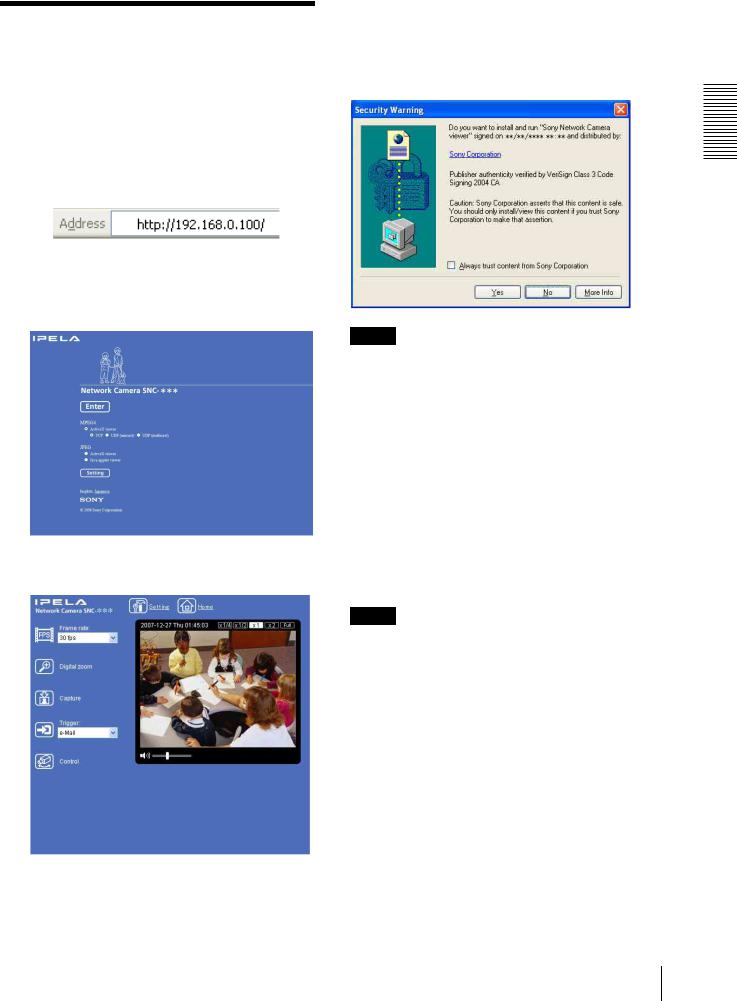
Accessing the Camera
Using the Web Browser
After the IP address has been assigned to the camera, check that you can actually access the camera using the Web browser installed on your computer.
Use Internet Explorer as the Web browser.
1 Start the Web browser on the computer and type the IP address of the camera in the URL box.
The welcome page of the network camera is displayed on the Web browser.
Display sample: SNC-DM160
2 Click Enter.
The main viewer is displayed.
If the main viewer is displayed correctly, accessing the camera is confirmed.
When the main viewer of the camera is displayed for the first time
When you click Enter, “Security Warning” is displayed. When you click Yes, ActiveX control is installed and the main viewer is displayed.
Notes
•If Automatic configuration is enabled in the Local Area Network (LAN) Settings of Internet Explorer, the image may not be displayed. In that case, disable
Automatic configuration and set the Proxy server manually. For the setting of the Proxy server, consult your network administrator.
•When you install ActiveX Control, you should be logged in to the computer as Administrator.
•When you are using Windows XP Service Pack 2 or Windows Vista, the information bar or “Security Warning” may appear as you click Enter. For details, see “Installing ActiveX Control” in “When using Windows XP Service Pack 2” on page 9 or “Installing ActiveX Control” in “When using Windows Vista” on page 11.
Tip
Every page of this software is optimized as display character size Medium for Internet Explorer.
To display the welcome page and the main viewer correctly
To operate the welcome page and the main viewer correctly, set the security level of the Internet Explorer to Medium or lower, as follows:
1 Select Tools from the menu bar for Internet Explorer, then select Internet Options and click the Security tab.
2 Click the Internet icon (when using the camera via the Internet) or Local intranet icon (when using the camera via a local network).
Preparation
Accessing the Camera Using the Web Browser 13

Preparation
3 Set the slider to Medium or lower. (If the slider is not displayed, click Default Level.)
When using antivirus software, etc. on the computer
•When you use antivirus software, security software, personal firewall or pop-up blocker on your computer, the camera performance may be reduced, for example, the frame rate for displaying the image may be lower.
•The Web page displayed when you log in to the camera uses JavaScript. The display of the Web page may be affected if you use antivirus software or other software described above on your computer.
14 Accessing the Camera Using the Web Browser

Basic Configuration by the Administrator
You can monitor the camera image by logging in with the initial conditions set for this network camera. You can also set various functions according to the installing position, network conditions or purpose of the camera. We recommend you configure the following items before monitoring images from the camera.
Setting contents |
Setting menu |
|
|
Synchronize the date and time of the camera with those of the computer. |
Date & time Tab (page 32) |
|
|
Prepare a full image. (SNC-DM110 / DM160 / CM120 only) |
Capture full image (page 34) |
|
|
Select whether to use the audio input. |
Audio input (page 35) |
|
|
Select the white balance mode according to the installing position (surrounding |
White balance (page 36) |
light). |
|
|
|
Set the brightness of the image sent from the camera. |
Exposure (page 36) |
|
|
Set the format and size of the image sent from the camera. |
Video codec Tab (page 40) |
|
|
Select the quality of the image sent from the camera. |
Video codec Tab (page 40) |
|
|
Set the user access right for the camera. |
User Menu (page 54) |
|
|
Set a place to be watched beforehand. (SNC-DM110 / DM160 / CM120 only) |
Preset position Menu (page 56) |
|
|
Make the setting for sending the monitor image attached to an e-mail. |
e-Mail (SMTP) Menu (page 59) |
|
|
Preparation
Basic Configuration by the Administrator |
15 |
|
|

Operating the Camera
Administrator and User
Camera the Operating
The Operating the Camera section explains how to monitor the image from the camera using your Web browser. Use Internet Explorer as the Web browser.
The functions of the camera should be set by the Administrator. For the setting of the camera, see “Administrating the Camera” on page 28.
This network camera identifies the people who log in as the Administrator or User.
The Administrator can use all the functions of this network camera including camera setting. The User can use the functions for monitoring the image and audio from the camera, and controlling the camera. The Viewer mode setting is used to restrict the user's access rights. There are five types of users.
Each type of user can use the corresponding functions below.
|
|
|
|
|
User |
|
|
Function |
Administrator |
|
|
|
|
|
|
|
Full |
Pan/Tilt4) |
Preset |
Light |
View |
||
|
|
|
|
|
position4) |
|
|
Monitor a live image |
z |
z |
z |
z |
z |
z |
|
|
|
|
|
|
|
|
|
View the date and time |
z |
z |
z |
z |
z |
z |
|
|
|
|
|
|
|
|
|
Receive the audio |
z |
z |
z |
z |
z |
z |
|
|
|
|
|
|
|
|
|
Control the image view size |
z |
z |
z |
z |
z |
– |
|
|
|
|
|
|
|
|
|
Zoom an image using the digital zoom |
z |
z |
z |
z |
z |
– |
|
|
|
|
|
|
|
|
|
Save a still image in the computer |
z |
z |
z |
z |
z |
– 1) |
|
Call the Preset position2) |
z |
z |
z |
z |
– |
– |
|
Perform the pan/tilt/zoom operation2) |
z |
z |
z |
– |
– |
– |
|
Control the frame rate (Available in JPEG mode only) |
z |
z |
– |
– |
– |
– |
|
|
|
|
|
|
|
|
|
Send an image file to the FTP server |
z |
z |
– |
– |
– |
– |
|
|
|
|
|
|
|
|
|
Send an image attached to an e-mail |
z |
z |
– |
– |
– |
– |
|
|
|
|
|
|
|
|
|
Record an image in the memory |
z |
z |
– |
– |
– |
– |
|
|
|
|
|
|
|
|
|
Control the alarm output of the I/O port on the camera |
z |
z |
– |
– |
– |
– |
|
|
|
|
|
|
|
|
|
Switch the Day/Night function mode3) |
z |
z |
– |
– |
– |
– |
|
Play an audio file (Voice alert) |
z |
z |
– |
– |
– |
– |
|
|
|
|
|
|
|
|
|
Control the setting menu |
z |
– |
– |
– |
– |
– |
|
|
|
|
|
|
|
|
|
z Usable –Not usable
1)This function is usable with the Java applet viewer.
2)Available only when SolidPTZ is enabled on SNC-DM110 / DM160 / CM120.
3)Available for SNC-DM160 / DS60 / CM120 / CS20.
4)Available for SNC-DM110 / DM160 / CM120.
The access rights of the administrator and the user can be set in “Setting the User — User Menu” of the Administrator menu on page 54.
16 Administrator and User
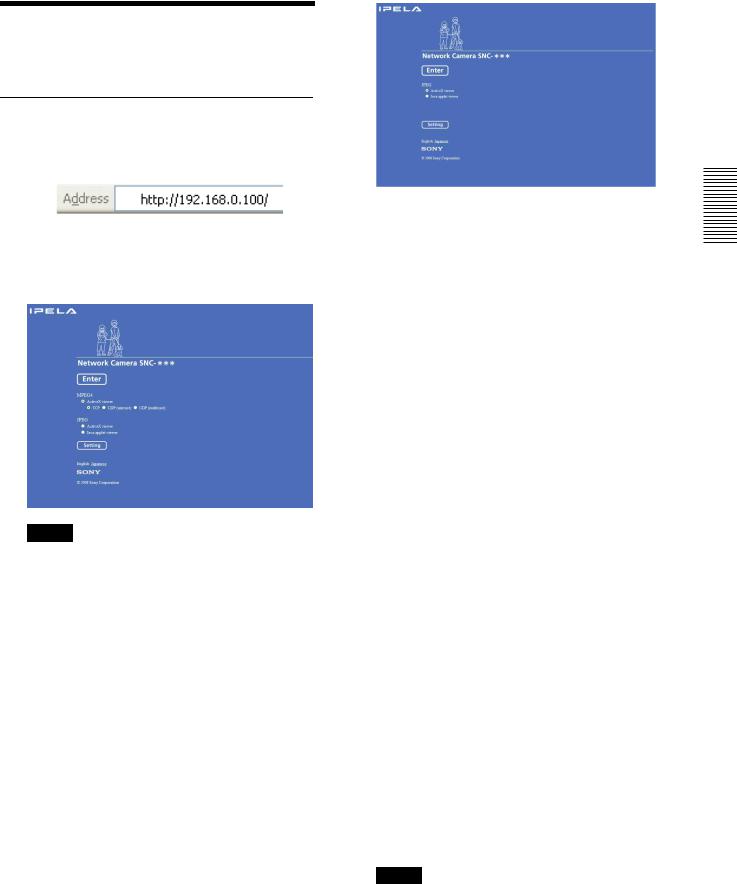
Logging in to Homepage
— Welcome Page
Logging in as a user
1 Start the Web browser on your computer and type the IP address of the camera you want to monitor.
The welcome page of the network camera is displayed on the Web browser.
Display sample: SNC-DM160
Note
If the welcome page does not start correctly, the security level of the Internet Explorer may be set to higher than Medium. See “To display the welcome page and the main viewer correctly” on page 13 and check the security level.
2 Select the viewer.
You can select ActiveX viewer when the video codec is MPEG4, and ActiveX viewer or Java applet viewer when the video codec is JPEG.
With SNC-DM110 / DM160 / CM120
When you select an item including MPEG4 - OFF on Image size (page 40) in the Video codec tab, you can see the image only on JPEG.
3 When you select ActiveX viewer on MPEG4 in step 2, select the communication port for the video/ audio data.
Click to select TCP, UDP (unicast) or UDP (multicast).
Normally select TCP.
TCP: This is normally selected.
When TCP is selected as the communication port, HTTP communication is adopted for video/ audio communications.
HTTP is the protocol used for reading the usual Web page.
In an environment capable of reading Web pages, you can watch or listen to the video/audio by selecting the TCP port.
UDP (unicast): When UDP (unicast) is selected as the communication port, RTP (Real-time Transport Protocol) is adopted for video/audio communications. Since RTP is the protocol for running video/audio data, the video/audio playback is smoother than when TCP (HTTP) is selected. If a firewall is installed between the camera and the computer, or depending on the network environment, the video/audio may not play back properly when UDP (unicast) is selected. In that case, select TCP.
UDP (multicast): This protocol is selectable when
Multicast streaming (page 45) is On. When
UDP (multicast) is selected as the communications port, RTP (Real-time Transport Protocol) and UDP multicast techniques are adopted for video/audio communications. By selecting it, the network communications load of the camera can be reduced. If a router that does not correspond to the multicast or a firewall is installed between the camera and the computer, the video/audio may not play back properly. In that case, select TCP or UDP (unicast).
Notes
•The function may not operate correctly when you use personal firewall software or antivirus
Camera the Operating
Logging in to Homepage — Welcome Page |
17 |
|
|
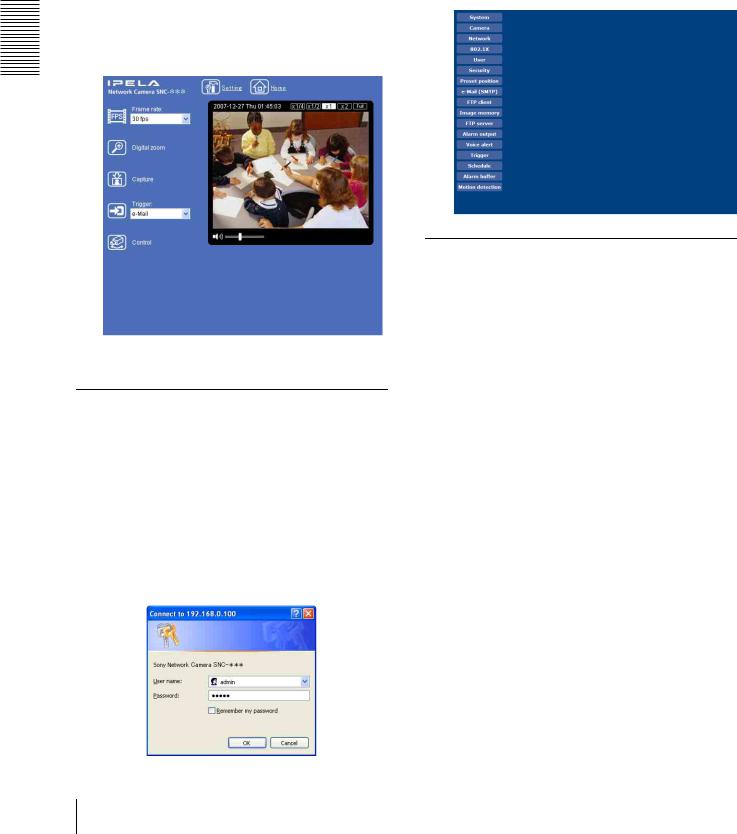
software on your computer. In that case, disable the software or select the TCP mode.
•If you are using Windows XP Service Pack 2 or Windows Vista, disable “Windows Firewall.” For details, see “Configuring Windows Firewall” in “When using Windows XP Service Pack 2” on page 8 or “Configuring Windows Firewall” in “When using Windows Vista” on page 10.
4 Click Enter.
The main viewer appears.
Display sample: SNC-DM160
With the ActiveX viewer (JPEG)
Camera the Operating
Control the camera from the main viewer.
Displaying the Administrator menu directly
When the administrator sets the camera functions, the Administrator menu can be opened directly from the welcome page.
1 Select the viewer language on the welcome page. Click English or Japanese at the bottom of the welcome page.
2 Click Setting on the welcome page. The following dialog appears.
3 Enter the user name and password for Administrator, then click OK.
The user name “admin” and the password “admin” are set at the factory for the Administrator. You can change them using the User menu of the Administrator menu (see page 54).
The Administrator menu appears in other window.
Display sample: SNC-DM160
About viewers
You can use the following viewers.
ActiveX viewer
This viewer can monitor the camera image in the JPEG or MPEG4 video codec.
You must install this viewer when you access the main viewer for the first time.
When you display the main viewer of the camera for the first time
When you log in the network camera using ActiveX viewer for the first time (by clicking Enter to enter the main viewer), the Security Warning appears. Click Yes and install ActiveX Control. You can use all the functions of the viewer with ActiveX Control.
Java applet viewer
You can select this viewer when the camera image is in JPEG. The frame rate is lower than the ActiveX viewer. The Java applet viewer operates only when Java is installed and Java (Sun) is enabled. If it does not operate correctly, check whether the Java has been installed successfully and Java (Sun) is enabled.
When the Java applet viewer is displayed, the dialog about digital-signature identification is also displayed. Click Run to go on.
For the verified Java version, contact your authorized Sony dealer.
18 Logging in to Homepage — Welcome Page
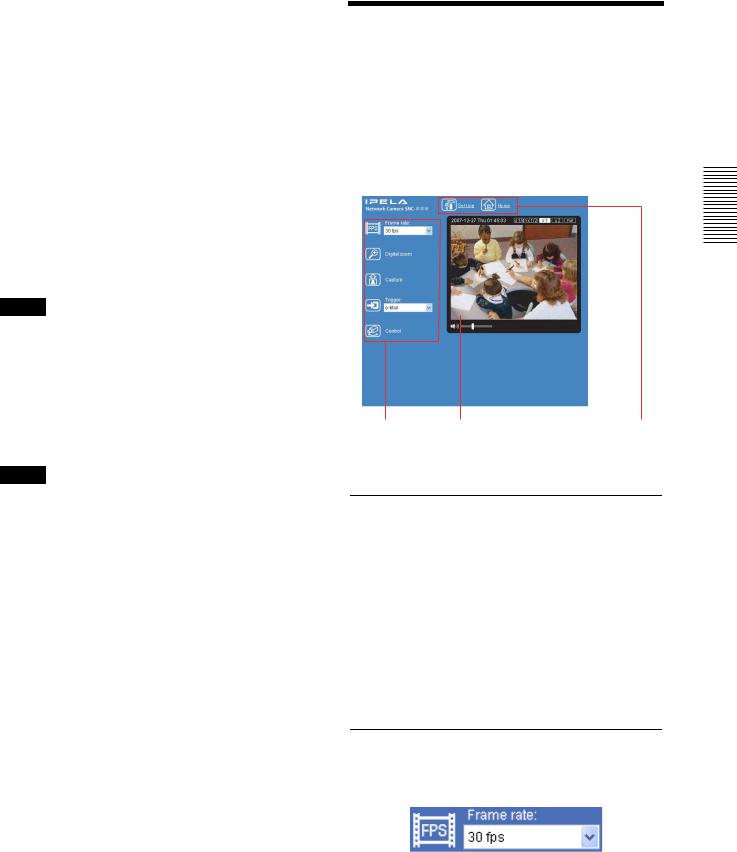
To check the Java version
Select Tools from the menu bar of Internet Explorer, then select Internet Options and click the Advanced mode tab. Check the version of Java displayed in Java (Sun). If Java (Sun) is not displayed, it means that Java is not installed. You need to install Java.
To enable Java Plug-in
Example: In case of Java Plug-in Ver. 1.6.0_01
Check “Use JRE 1.6.0_01 for <applet> (requires restart)” in “Java (Sun)”.
To install Java Plug-in
Download Java 2 Runtime Environment, Standard Edition (JRE) from the website of Sun Microsystems, Inc., and install it by following the instructions on the installer.
Notes
•If Automatic configuration is enabled in the Local Area Network (LAN) Settings of Internet Explorer, the camera image may not be displayed. In that case, disable Automatic configuration and set the Proxy server manually. For the setting of the Proxy server, consult your network administrator.
•When you install ActiveX Control, you should be logged in to the computer as the Administrator.
Tip
Every page of this software is optimized for display character size Medium for Internet Explorer.
Configuration of Main
Viewer
This section explains the functions of the parts and controls of the main viewer. For a detailed explanation on each part or control, see the specified pages.
Display sample: SNC-DM160
Main viewer using ActiveX viewer (JPEG)
Camera control |
Monitor image |
Main menu |
section |
section |
|
Main menu
 Setting
Setting
Click to display the Administrator menu. (page 28) You can operate this function only when logging in as the administrator.
 Home
Home
Displays the welcome page.
Camera control section
Frame rate
(Displayed only when the camera image is in JPEG.)
Selects the frame rate to transmit images. (page 21)
Camera the Operating
Configuration of Main Viewer |
19 |
|
|
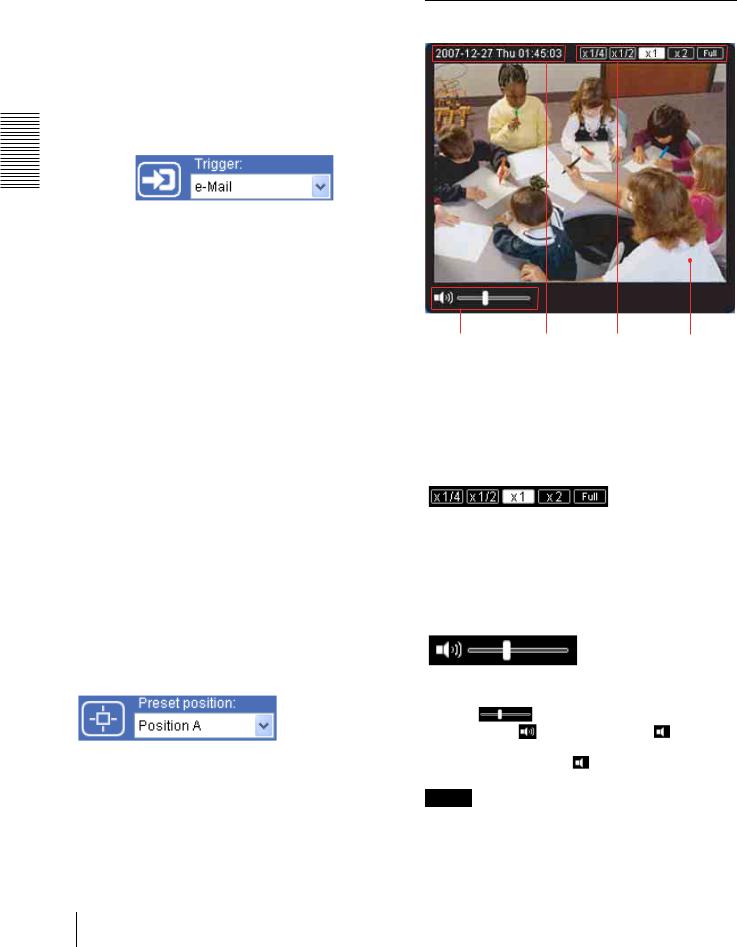
Camera the Operating

 Digital zoom
Digital zoom
Click to change the size of the digital zoom. (page 22)
 Capture
Capture
(Displayed in the main menu when the Java applet viewer is used.)
Click to capture a still image shot by the camera and to store it in the computer. (page 22)
Trigger
(Displayed only when the camera Viewer mode (page 55) is set to Full and one or more triggers are enabled in the Trigger menu (page 71).)
Select the function you want to use from the drop-down list and click  . The selected function is activated. The selectable functions are as follows:
. The selected function is activated. The selectable functions are as follows:
–send the still images attached to an e-mail (page 26)
–send the still images to an FTP server (page 26)
–record the still image files in the built-in memory (page 26)
–control the alarm output (page 26)
–switch the Day/Night function on/off (SNC-DM160 / DS60 / CM120 / CS20 only) (page 26)
–play the audio file stored in the camera (page 27)
 Control (SNC-DM110 / DM160 / CM120 only)
Control (SNC-DM110 / DM160 / CM120 only)
(Displayed only when the SolidPTZ function is On. (page 42))
Click to operate the camera using the pan, tilt and zoom functions.
Click to change this icon to  , and you can operate pan/tilt/zoom on the monitor or control panel (page 23).
, and you can operate pan/tilt/zoom on the monitor or control panel (page 23).
Preset position (SNC-DM110 / DM160 / CM120 only)
(Displayed only when the SolidPTZ function is On (page 42) and preset position of the camera is registered.)
Select the Preset position name from the drop-down list. The camera will move to the preset display range
that you have stored in memory using the Preset position menu.
Monitor image section
Volume |
Date and time |
View size |
Monitor |
|
|
|
window |
Monitor window
The image shot by the camera is shown here.
View size
Selects the view size to be displayed. (page 22)
Date and time
The date and time is displayed here.
Volume
(Displayed when Audio input (page 35) is set to On.)
Drag the |
bar to adjust the volume. |
||
When you click |
the icon changes to |
and the |
|
audio output stops. |
|
|
|
To output the audio, click |
again. |
|
|
Note
If  does not appear when the Java applet viewer is used, Audio encode may not be set to G.711 (64 kbps) (page 36), or Java may not be installed
does not appear when the Java applet viewer is used, Audio encode may not be set to G.711 (64 kbps) (page 36), or Java may not be installed
20 Configuration of Main Viewer
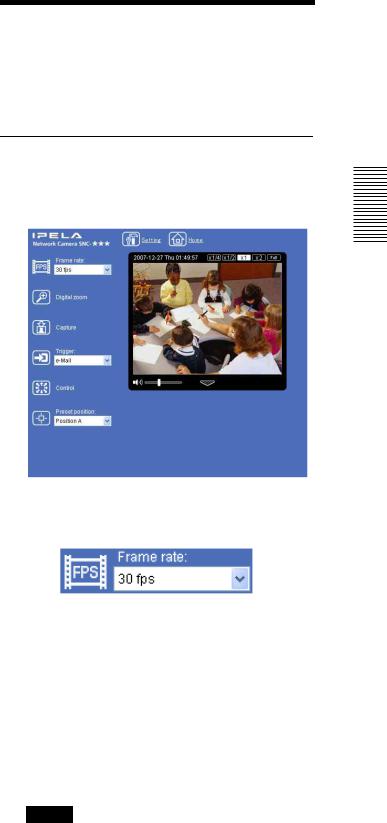
correctly. To check if Java is installed correctly, refer to “Java applet viewer” of “About viewers” on page 18.
Controlling the Monitor
Image
You can monitor the camera image on the monitor window of the main viewer.
Monitoring the camera image
1 Log in to the homepage to display the main viewer. To log in, see “Logging in as a user” on page 17.
Camera the Operating
2 Select the frame rate (only when the camera image is in JPEG).
Click the Frame rate list box to select the frame rate for transmitting the image. Selectable frame rates are as follows.
1, 2, 3, 4, 5, 6, 8, 10, 15, 20, 25, 30 fps
“fps” is a unit indicatings the number of frames transmitted per second.
For example, if you select 30 fps, the image is sent at the maximum speed of the connected line (30 fps maximum).
Note
The selected value indicates the maximum number of frame rate that can be transmitted.
The number of frames actually transmitted may vary depending on network environments and
Controlling the Monitor Image |
21 |
|
|
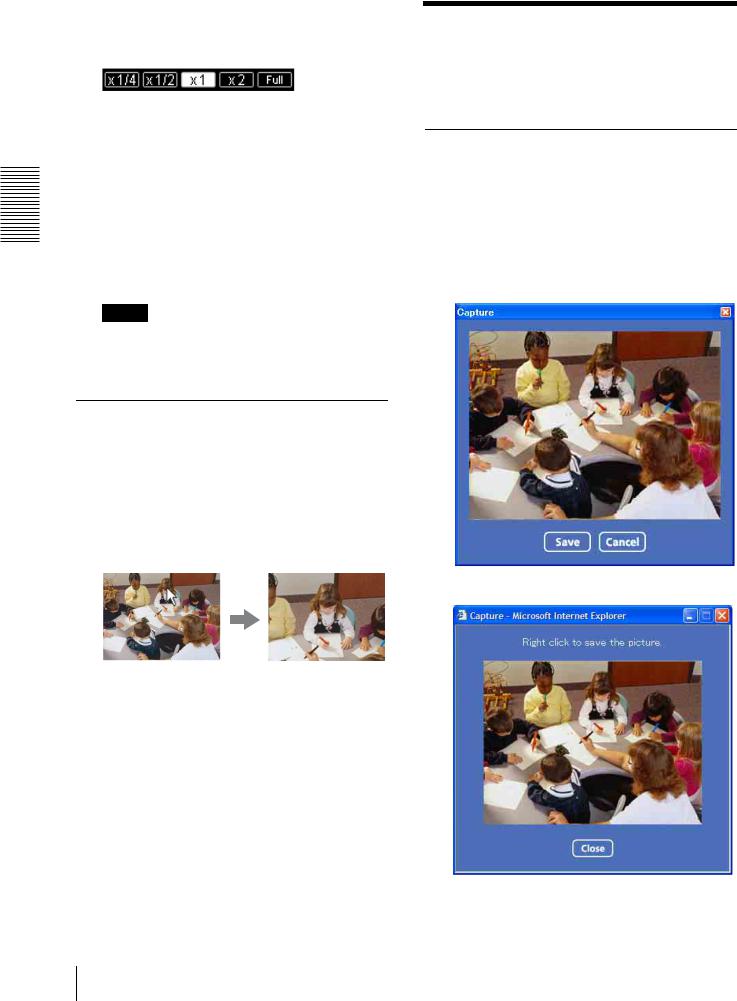
Camera the Operating
camera settings (image size and image quality settings).
3 Select the view size.
Select × 1/4, × 1/2, × 1, × 2 or Full at the top of the image. The monitor is displayed by the view size as you selected.
The selected image size button flips.
×1: Displayed in the selected image size selected on Image size in the camera menu (page 40).
×2: Available only when the view size is 640 × 480 (VGA) size or less.
Full: A full image is displayed with one click.
When you return to the normal screen from the full image, right-click or click ESC on the keyboard.
Note
When the full image is displayed, you cannot operate pan/tilt/zoom with SolidPTZ function. (SNC-DM110 / DM160 / CM120 only)
Zooming in the monitor image
1 Click  .
.
With the ActiveX viewer, a green frame indicates the range to be zoomed in.
2 Click the point you want to zoom in.
The image is magnified about twice with the clicked point at the center.
The digital zoom icon changes to  .
.
3 To cancel zooming in, click  .
.
Capturing a Monitor
Image
You can capture an image being monitored as a still image and save it in the computer.
Capturing a monitor image
1 Display the camera image in the monitor window.
2 Click  .
.
The still image of the moment you click is captured, and this still image is displayed in the capture window.
With the ActiveX viewer
With the Java applet viewer
3 To close the capture window, click Cancel or
Close.
22 Capturing a Monitor Image
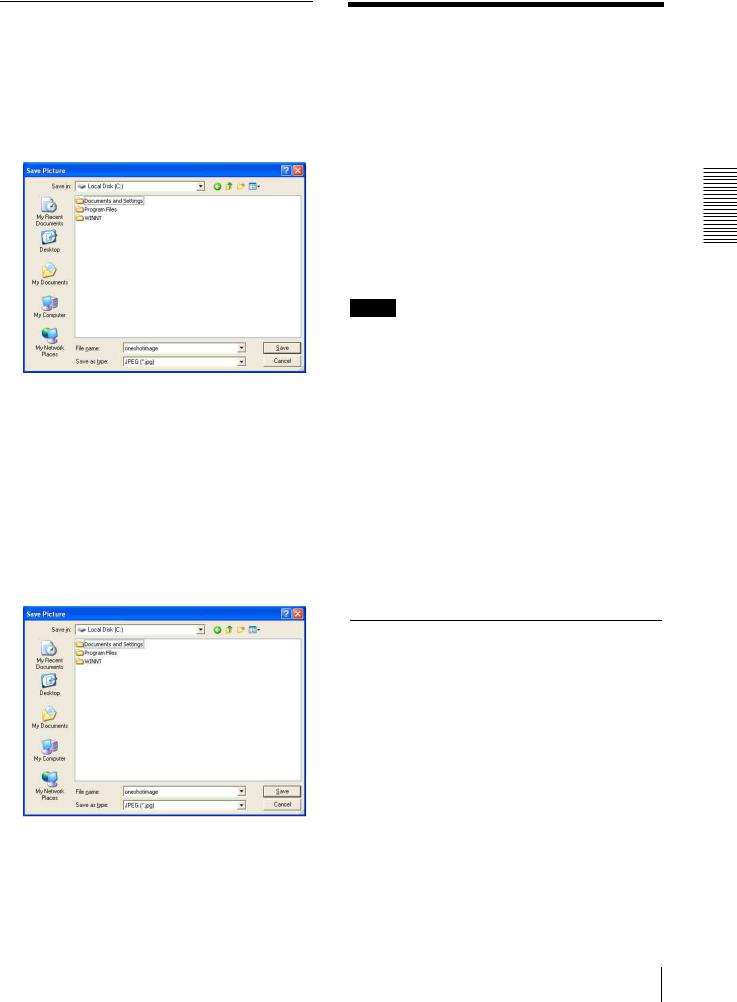
Saving the captured image
With the ActiveX viewer
1 Capture the monitor image.
2 Click Save.
The Save As dialog appears.
3 Select JPEG or BITMAP as Save as type.
4 Type the File name and specify Save in, then click
Save.
With the Java applet viewer
1 Capture the monitor image.
2 Right-click the mouse to display the menu and select Save Picture As....
The Save Picture dialog appears.
Operating the Camera Using SolidPTZ (SNCDM110 / DM160 / CM120 only)
You can operate pan/tilt/zoom with the SolidPTZ function.
SolidPTZ reduces or crops an image shot in Quad-VGA (1280 × 960) while adjusting the image position and ratio. The pan/tilt/zoom effect is seen on the screen although the camera and lens do not actually move. This function helps in effectively monitoring the image range while saving the network bandwidth or the recording area.
Notes
•When the SolidPTZ is disabled (page 42), you cannot operate pan/tilt/zoom or preset position.
•Available pan-tilt range
This function is controlled by reducing and/or cropping an image shot in Quad-VGA size. If the image is zoomed to WIDE, you can get only a small pan-tilt range and pan/tilt does not work at the WIDE end.
•Available zoom range
When an image is zoomed in to the TELE end, the image size is the same as the actual image shot in Quad-VGA (× 1). You cannot zoom an image beyond what it actually is.
The image ratio when zoomed out to the WIDE end is different depending on the output image size set. (For example, when the VGA output image size is set, the image can be zoomed out to half.)
Controlling via the control panel
You can operate pan, tilt and zoom by using the control panel for the monitor image currently displayed.
1 Click  to display
to display  , and the control panel. With another click of
, and the control panel. With another click of  , the control panel is displayed again.
, the control panel is displayed again.
3 Select JPEG or BITMAP as Save as type.
4 Type in File name and specify Save in, then click
Save.
Camera the Operating
Operating the Camera Using SolidPTZ (SNC-DM110 / DM160 / CM120 only) 23
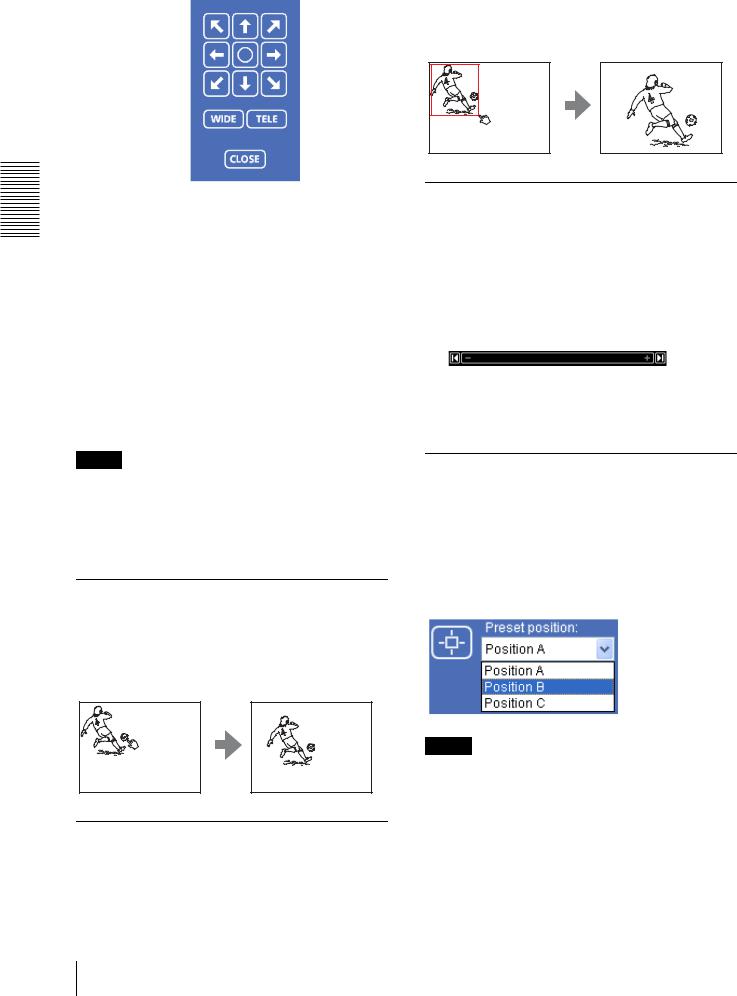
Camera the Operating
2 Control each function using the displayed control panel.
Pan/Tilt control
Click the arrow button of the direction in which you want to move the camera. Keep it pressed to move the display area of the image continuously.
To return to the home position, click  .
.
You can select the operation mode of the 8-direction arrow buttons for panning and tilting in PTZ mode of the System menu (page 31).
Zoom control
Click  to zoom out, and click
to zoom out, and click  to zoom in. Zooming continues while the button remains pressed.
to zoom in. Zooming continues while the button remains pressed.
Note
When Exclusive control mode of the System menu is set to On and you click  , the remaining time that you are authorized to operate the camera is displayed. If you cannot get the control, the icon switches to
, the remaining time that you are authorized to operate the camera is displayed. If you cannot get the control, the icon switches to  and the waiting time is displayed.
and the waiting time is displayed.
Panning and tilting by clicking the monitor image
Click on the monitor image, and the display area moves so that the clicked portion is positioned at the center of the display.
Panning, tilting and zooming by specifying the area
Click and hold the left button of the mouse on the monitor image and drag the mouse diagonally to draw a
red frame around the portion you want to enlarge. The framed portion is positioned at the center of the display and is zoomed in.
Zooming an image by the camera zoom bar
When you have authorization to control this function, the zoom bar is displayed below the monitor window. You can specify a location to be zoomed by clicking the zoom bar.
The zoom bar is either displayed or turned off by clicking  below the bar.
below the bar.
 WIDE end: Click to move the zoom to WIDE end (same magnification).
WIDE end: Click to move the zoom to WIDE end (same magnification).
 TELE end: Click to move the zoom to TELE end.
TELE end: Click to move the zoom to TELE end.
Displaying the preset area of the image
Select a preset position name from the Preset position drop-down list. The display area that you have stored in memory is displayed using the Preset position menu (page 56). When you click this icon after the control panel moves the display area, the image previously selected from the preset position list box reappears.
Note
The Preset position list box is not displayed when no preset position is memorized.
24 Operating the Camera Using SolidPTZ (SNC-DM110 / DM160 / CM120 only)
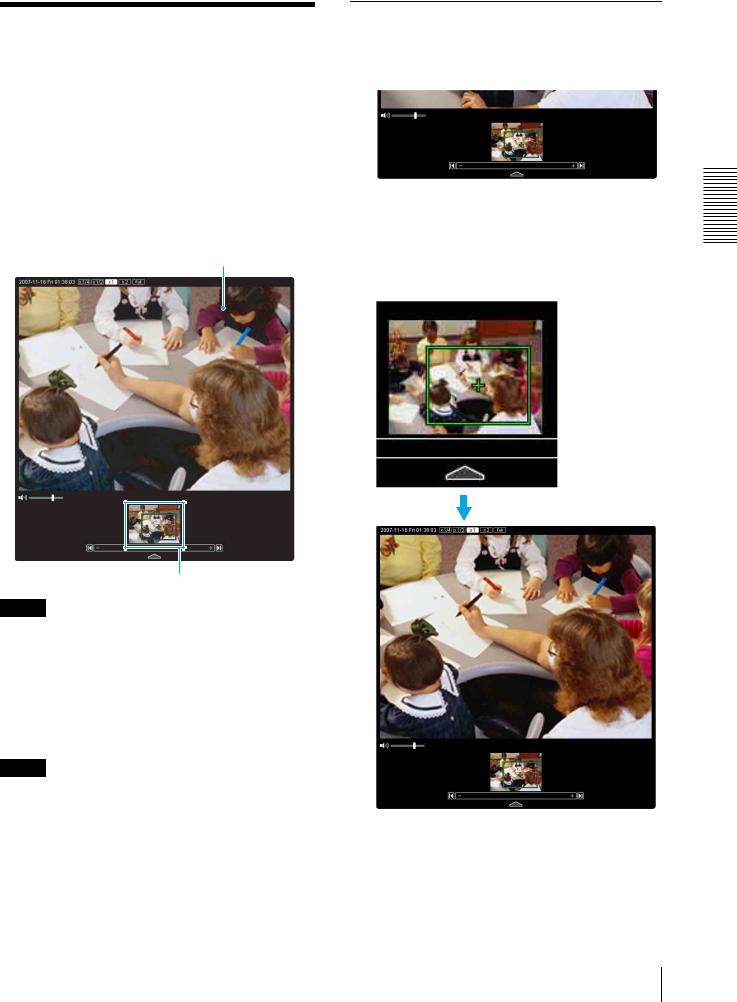
Controlling the Camera on a Full Image (SNCDM110 / DM160 / CM120 only)
When you have authorization to control the camera, the full image is displayed under the monitor window. The full image is a still image that shows the entire shooting range of the camera in reduced size. When you click on the full image, the clicked portion is displayed in the monitor window.
Monitor window
Full image
Note
When the SolidPTZ is disabled (page 42), you cannot control the camera on a full image.
To create a full image
Create a full image using Capture full image in the Initialize tab of the System menu.
For details, see page 34.
Tip
When the camera is moved or when the layout around the camera is changed, you should create the full image again.
Displaying a specified point in the monitor window
1 Create a full image and display it.
2 Click the point you want to watch in the full image. The current image at the selected point is displayed in the monitor window.
You can see a green frame on the full image. This indicates the image currently displayed in the motion window you are watching.
Click the point you want to watch in full image.
The current situation is displayed in the monitor window at the clicked point.
To turn off the full image
When you click  , the full image and the zoom bar disappear.
, the full image and the zoom bar disappear.
Camera the Operating
Controlling the Camera on a Full Image (SNC-DM110 / DM160 / CM120 only) 25
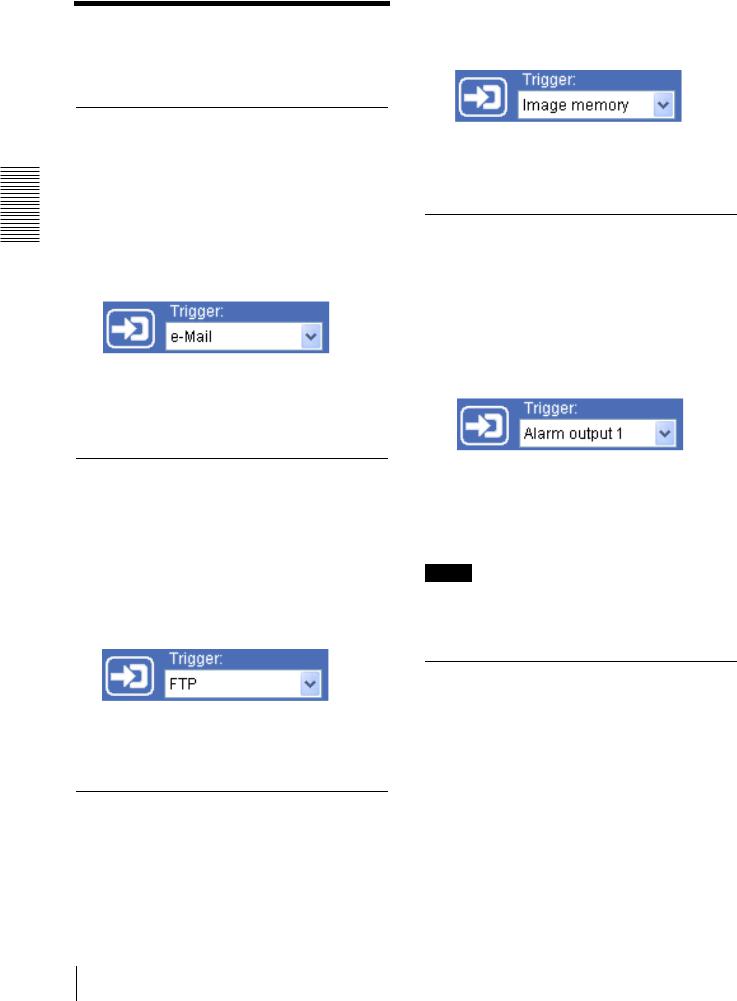
Camera the Operating
Using the Trigger Button
You can operate various functions of the camera simply by clicking  (trigger) in the main viewer.
(trigger) in the main viewer.
Sending a monitor image via e-mail
You can send a captured still image by attaching it to an e-mail.
To use this function, you need to make e-Mail (SMTP) active and set the address in the Trigger menu of the Administrator menu properly (page 71).
1 Display the image on the monitor window.
2 Select e-Mail from the trigger drop-down list.
3 Click  .
.
The still image of the moment you click is captured, and your e-mail with the image file attached is sent to the specified mail address.
Sending a monitor image to an FTP server
You can send a captured still image to the FTP server. To use this function, you need to make FTP client active and set the address in the Trigger menu of the Administrator menu properly (page 71).
1 Display the image on the monitor window.
2 Select FTP from the trigger drop-down list.
3 Click  .
.
The still image of the moment you click is captured, and the image file is sent to the FTP server.
Recording a camera image as a still image
You can capture a camera image as a still picture and record it in the built-in memory.
To use this function, you need to make Image memory active and set the details in the Trigger menu of the Administrator menu (page 71).
1 Display the image on the monitor window.
2 Select Image memory from the trigger drop-down list.
3 Click  .
.
The still image of the moment you click is captured, and the image file is recorded.
Controlling alarm output 1, 2
You can control Alarm output 1, 2.
To use this function, you need to make Alarm output 1 or Alarm output 2 active in the Trigger menu of the Administrator menu (page 72).
1 Display the image on the monitor window.
2 Select Alarm output1 or Alarm output2 from the trigger drop-down list.
3 Click  .
.
The alarm output is switched by clicking. The alarm output mode can be selected from
Toggle or Timer of Alarm output 1, 2 in the Trigger menu (page 72).
Tip
For the connection of peripheral devices to the alarm output of the I/O port, see the supplied Installation Manual.
Controlling Day/Night function (SNC-DM160 / DS60 / CM120 / CS20 only)
You can control the Day/Night function On (night mode) and Off (day mode).
To use this function, you need to make Day/Night active in the Trigger menu of the Administrator menu
(page 72).
1 Display the image on the monitor window.
26 Using the Trigger Button
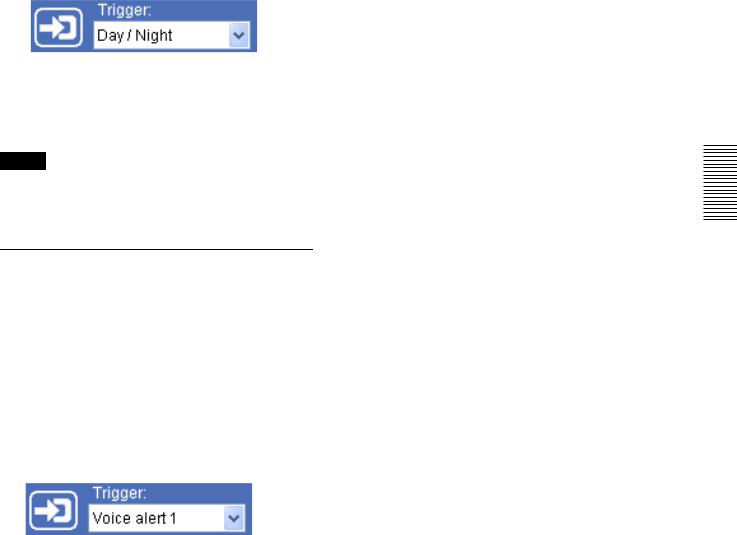
2 Select Day/Night from the trigger drop-down list.
3 Click  .
.
Each click switches the Day/Night function alternately between On (night mode) and Off (day mode).
Note
If Day/Night mode in the Trigger-Day/Night menu (page 72) is set to Auto, you cannot control the Day/ Night function by clicking  .
.
Playing the audio file stored in the camera
You can play the audio file previously stored in the camera using the SNC audio upload tool.
To use this function, you need to make Voice alert1, Voice alert2 and Voice alert3 active in the Trigger menu of the Administrator menu (page 72).
1 Display the image on the monitor window.
2 Select Voice alert1, Voice alert2 or Voice alert3 from the trigger drop-down list.
3 Click  .
.
Playback of the selected audio file starts and the playback sound is output from the speaker connected to the camera.
Camera the Operating
Using the Trigger Button |
27 |
|
|
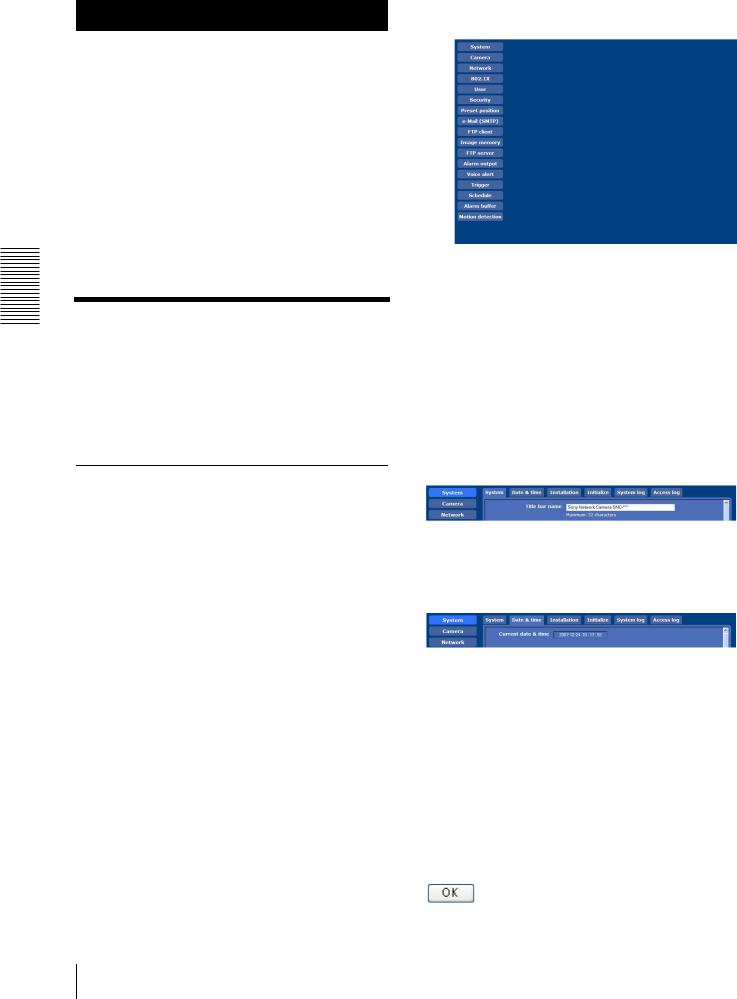
Camera the Administrating
Administrating the Camera
The Administrating the Camera section explains how to set the functions of the camera by the Administrator. For the monitoring of the camera image, see “Operating the Camera” on page 16.
This section explains the basic operations and each option of the Administrator menu.
Note on the display of menu options
The setting menus of this unit will clearly display only the setting options that you can currently select. The grayed out options cannot be selected.
Basic Operations of
Administrator Menu
You can use the Administrator menu to set all functions to suit the user's needs.
Click Setting in the welcome page or  in the main viewer to display the Administrator menu.
in the main viewer to display the Administrator menu.
How to setup the Administrator menu
1 Log in the homepage to display the welcome page. You can learn how to log in on page 17 “Logging in as a user”.
2 Select the viewer language on the welcome page. Click English or Japanese at the bottom of the welcome page.
3 Click Setting on the welcome page. The authentication dialog appears. Enter the user name and password for
Administrator. Administrator menu appears.
The user name “admin” and password “admin” are set at the factory for the Administrator.
The following steps also display the Administrator menu.
1Click Enter in the welcome page to display the main viewer.
2 Click  in the main viewer.
in the main viewer.
3Enter the user name and password for Administrator.
4 Click the menu name (example: System) on the left side of the Administrator menu.
The clicked menu appears.
Example: “System” menu
5 Select the required tab above the menu, and set each setting option in the tab.
Example: “Date & time” tab of “System” menu
See pages 26 to 74 for details of the menu tabs and setting options.
6 After setting, click OK.
The settings you have made become active.
Click Cancel to invalidate the set values and return to the previous settings.
Buttons common to every menu
The following buttons are displayed on all the menus. The functions of the buttons are the same on every menu.
Click this button to validate the settings.
28 Basic Operations of Administrator Menu
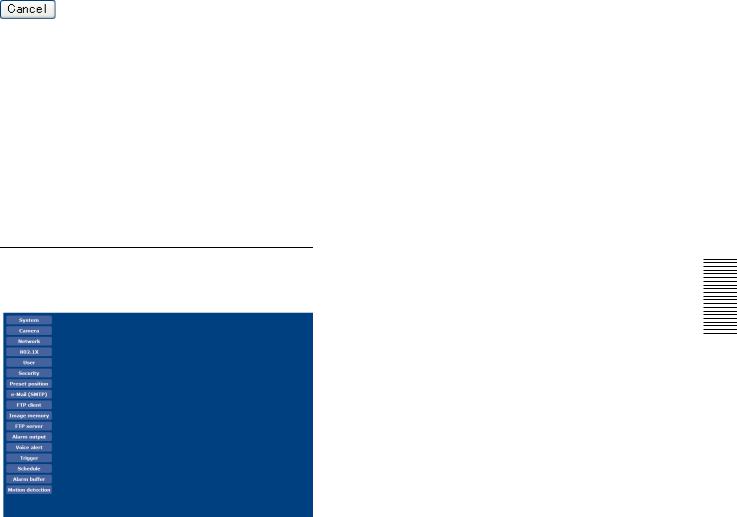
Click this button to invalidate the set values and return to the previous settings.
General notes on menus
•After changing a setting on a menu, wait at least 10 seconds before turning off the power of the camera. If the power is turned off immediately, the changed setting may not be stored correctly.
•When the camera settings are changed while watching the main viewer, some settings cannot be restored. To reflect the change on the opening main viewer, click Refresh of the web browser.
Configuration of Administrator menu
Display sample: SNC-DM160
System
Displays the System menu. (“Configuring the System — System Menu” on page 30)
Camera
Displays the Camera menu for setting the camera image and audio. (“Setting the Camera Image and Audio — Camera Menu” on page 35)
Network
Displays the Network menu for setting the network connection. (“Configuring the Network — Network Menu” on page 46)
802.1X
Displays the 802.1X menu for connecting the camera to the network configured in compliance with the 802.1X standard for port authentication. (“Using the 802.1X Authentication Function — 802.1X Menu” on page 49)
User
Displays the User menu for setting the log in user name and password. (“Setting the User — User Menu” on page 54)
Security
Displays the Security menu for specifying a computer that is allowed to connect to the camera. (“Setting the Security — Security Menu” on page 55)
Preset position (SNC-DM110 / DM160 / CM120 only)
Displays the Preset position menu to register a position you want to save.“Tour function”, which rotates the registered positions, is also set here. (“Saving the SolidPTZ Display Area and Action — Preset position Menu (SNC-DM110 / DM160 / CM120 only)” on page 56)
e-Mail (SMTP)
Displays the e-Mail (SMTP) menu for sending an e- mail. (“Sending an Image via E-mail — e-Mail (SMTP) Menu” on page 59)
FTP client
Displays the FTP client menu for sending an image/ audio file, etc. to an FTP server. (“Sending Images to FTP Server — FTP client Menu” on page 62)
Image memory
Displays the Image memory menu for recording an image/audio file, etc. in the built-in memory. (“Recording Images in Memory — Image memory Menu” on page 65)
FTP server
Displays the FTP server menu for setting the FTP server function of the camera. (“Downloading Images from the Camera — FTP server Menu” on page 68)
Alarm output
Displays the Alarm output menu for setting the alarm out terminal of the camera. (“Setting the Alarm Output
— Alarm output Menu” on page 69)
Voice alert
Displays the Voice alert menu for playing the audio file stored in the camera in synchronization with alarm detection by the sensor input or the motion detection function. (“Outputting Audio Linked to Alarm Detection — Voice alert Menu” on page 70)
Trigger
Displays the Trigger menu for operations when you click the trigger button in the main viewer. (“Setting the Operations from the Viewer — Trigger Menu” on page 71)
Schedule
Displays the Schedule menu for the Sense up function, Preset position function, e-Mail (SMTP) function, FTP
Basic Operations of Administrator Menu |
29 |
|
|
Camera the Administrating
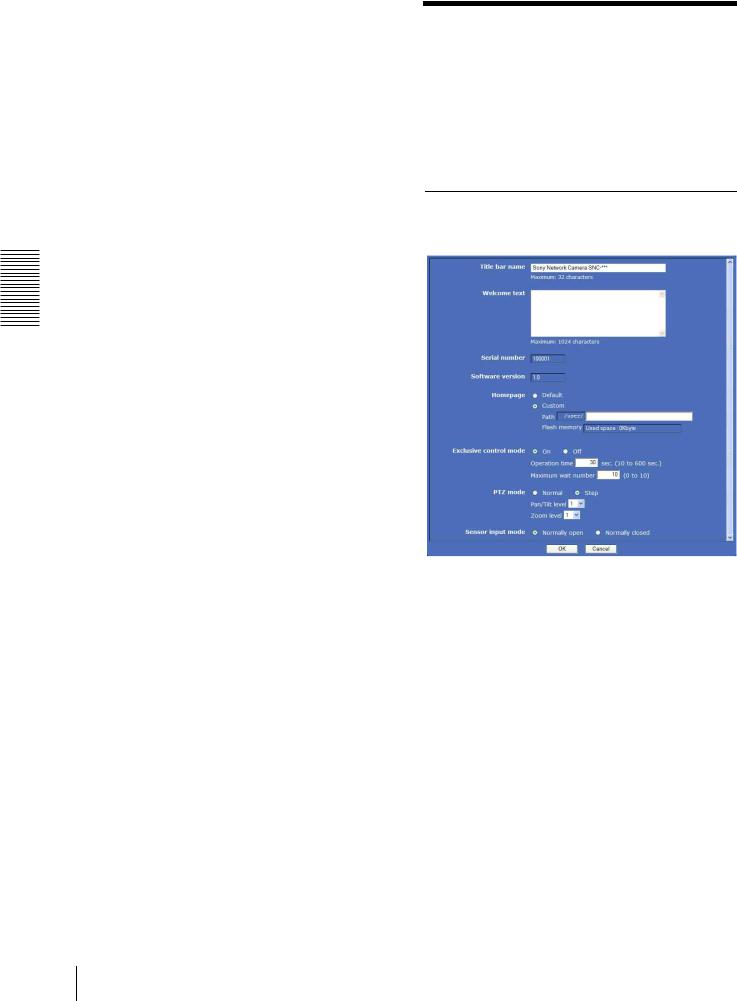
client function, Image memory function and Alarm out function, Voice alert function and so on. (“Setting the Schedule — Schedule Menu” on page 73)
Alarm buffer
Displays the Alarm buffer menu for the buffer that records the image and audio related to alarm detection. (“Setting the Alarm Buffer — Alarm buffer Menu” on page 74)
Motion detection
Displays the Motion detection menu for the motion detection function built into the camera. (“Setting the Motion Detection Function — Motion detection Menu” on page 75)
Camera the Administrating
Configuring the System
— System Menu
When you click  in the Administrator menu, the System menu appears.
in the Administrator menu, the System menu appears.
Use this menu to perform the principal settings of the software.
The System menu has six tabs: System, Date & time,
Installation, Initialize, System log and Access log.
System Tab
Display sample: SNC-DM160
Title bar name
Type a name of up to 32 characters to be displayed on the title bar. The characters typed here are displayed on the title bar of the Web browser.
Welcome text
Type any text of up to 1024 characters in HTML format to show on the welcome page. Use the <BR> tag for a line break. (A line break is equivalent to 2 characters.)
Serial number
The serial number of the camera is displayed.
Software version
The software version of this camera is displayed.
Homepage
Select the homepage to be displayed when you enter the camera IP address in your browser’s web address box.
Default: Displays the homepage stored in the camera.
30 Configuring the System — System Menu
